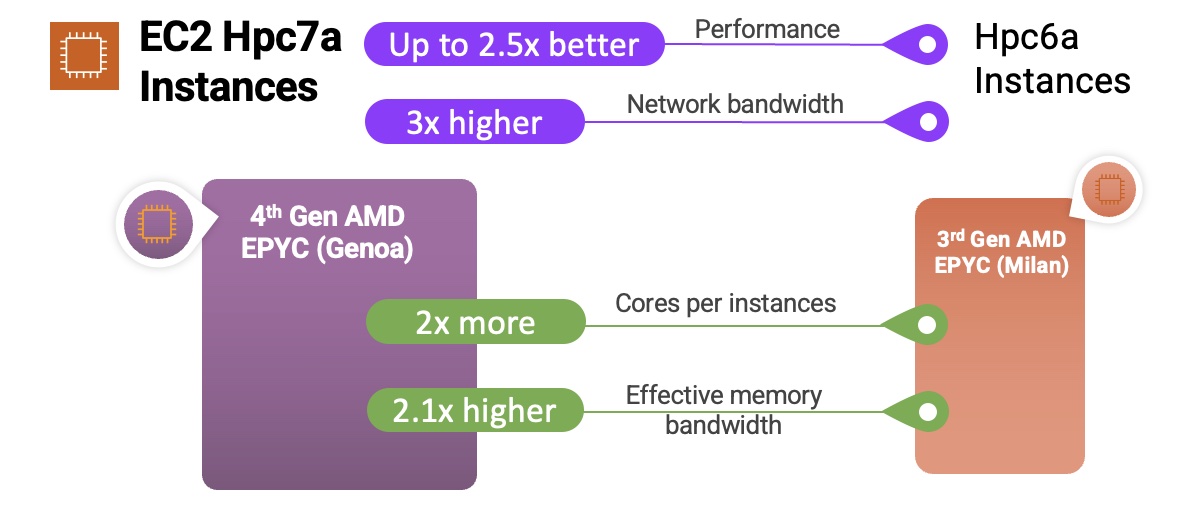New – Amazon EC2 Hpc7a Instances Powered by 4th Gen AMD EPYC Processors Optimized for High Performance Computing
In January 2022, we launched Amazon EC2 Hpc6a instances for customers to efficiently run their compute-bound high performance computing (HPC) workloads on AWS with up to 65 percent better price performance over comparable x86-based compute-optimized instances.
As their jobs grow more complex, customers have asked for more cores with more compute performance and more memory and network performance to reduce the time to complete jobs. Additionally, as customers look to bring more of their HPC workloads to EC2, they have asked how we can make it easier to distribute processes to make the best use of memory and network bandwidth, to align with their workload requirements.
Today, we are announcing the general availability of Amazon EC2 Hpc7a instances, the next generation of instance types that are purpose-built for tightly coupled HPC workloads. Hpc7a instances powered by the 4th Gen AMD EPYC processors (Genoa) deliver up to 2.5 times better performance compared to Hpc6a instances. These instances offer 300 Gbps Elastic Fabric Adapter (EFA) bandwidth powered by the AWS Nitro System, for fast and low-latency internode communications.
Hpc7a instances feature Double Data Rate 5 (DDR5) memory, which provides 50 percent higher memory bandwidth compared to DDR4 memory to enable high-speed access to data in memory. These instances are ideal for compute-intensive, latency-sensitive workloads such as computational fluid dynamics (CFD) and numerical weather prediction (NWP).
If you are running on Hpc6a, you can use Hpc7a instances and take advantage of the 2 times higher core density, 2.1 times higher effective memory bandwidth, and 3 times higher network bandwidth to lower the time needed to complete jobs compared to Hpc6a instances.
Here’s a quick infographic that shows you how the Hpc7a instances and the 4th Gen AMD EPYC processor (Genoa) compare to the previous instances and processor:

Hpc7a instances feature sizes of up to 192 cores of the AMD EPYC processors CPUs with 768 GiB RAM. Here are the detailed specs:
| Instance Name | CPUs | RAM (Gib) |
EFA Network Bandwidth (Gbps) |
Attached Storage |
| Hpc7a.12xlarge | 24 | 768 | Up to 300 | EBS Only |
| Hpc7a.24xlarge | 48 | 768 | Up to 300 | EBS Only |
| Hpc7a.48xlarge | 96 | 768 | Up to 300 | EBS Only |
| Hpc7a.96xlarge | 192 | 768 | Up to 300 | EBS Only |
These instances provide higher compute, memory, and network performance to run the most compute-intensive workloads, such as CFD, weather forecasting, molecular dynamics, and computational chemistry on AWS.
Similar to EC2 Hpc7g instances released a month earlier, we are offering smaller instance sizes that makes it easier for customers to pick a smaller number of CPU cores to activate while keeping all other resources constant based on their workload requirements. For HPC workloads, common scenarios include providing more memory bandwidth per core for CFD workloads, allocating fewer cores in license-bound scenarios, and supporting more memory per core. To learn more, see Instance sizes in the Amazon EC2 Hpc7 family – a different experience in the AWS HPC Blog.
As with Hpc6a instances, you can use the Hpc7a instance to run your largest and most complex HPC simulations on EC2 and optimize for cost and performance. You can also use the new Hpc7a instances with AWS Batch and AWS ParallelCluster to simplify workload submission and cluster creation. You can also use Amazon FSx for Lustre for submillisecond latencies and up to hundreds of gigabytes per second of throughput for storage.
To achieve the best performance for HPC workloads, these instances have Simultaneous Multithreading (SMT) disabled, they’re available in a single Availability Zone, and they have limited external network and EBS bandwidth.
Now Available
Amazon EC2 Hpc7a instances are available today in three AWS Regions: US East (Ohio), EU (Ireland), and US GovCloud for purchase in On-Demand, Reserved Instances, and Savings Plans. For more information, see the Amazon EC2 pricing page.
To learn more, visit our Hpc7a instances page and get in touch with our HPC team, AWS re:Post for EC2, or through your usual AWS Support contacts.
— Channy
Source: AWS News